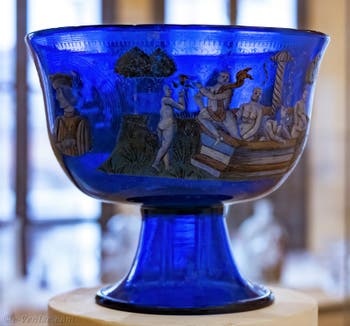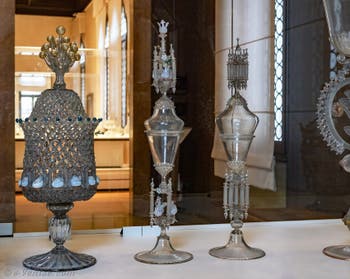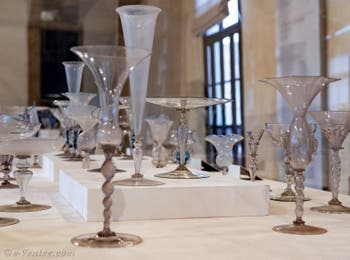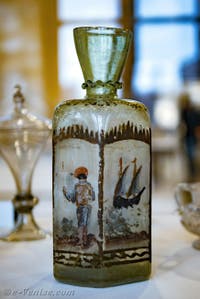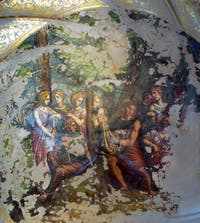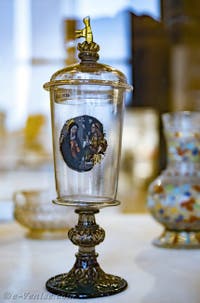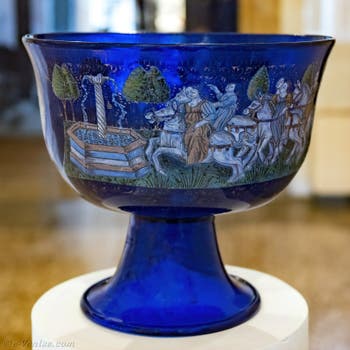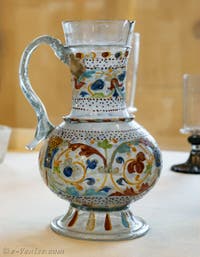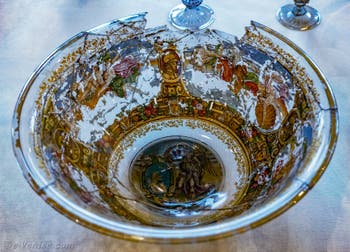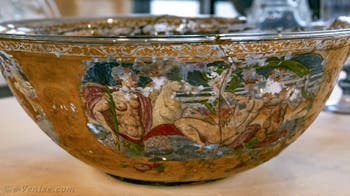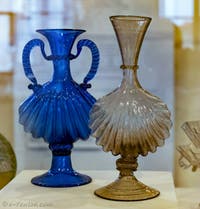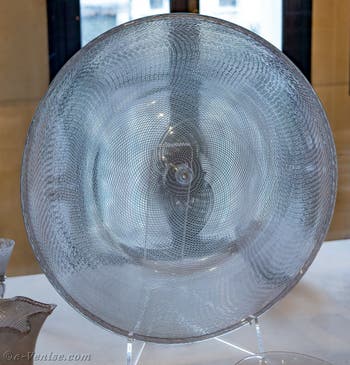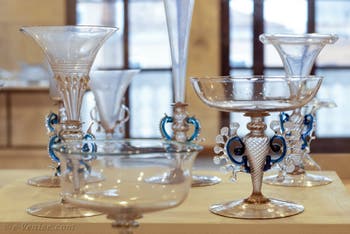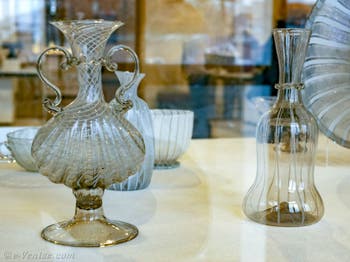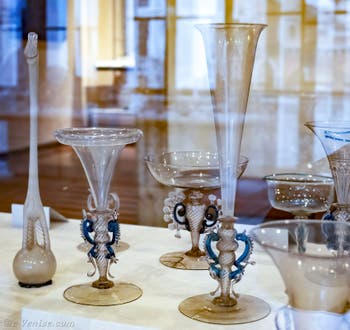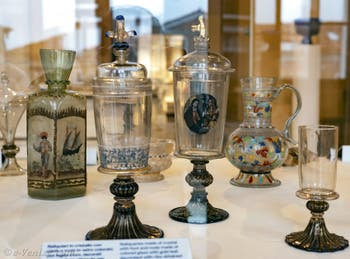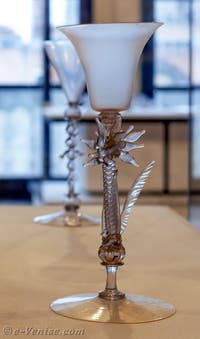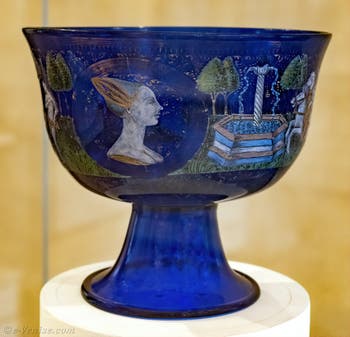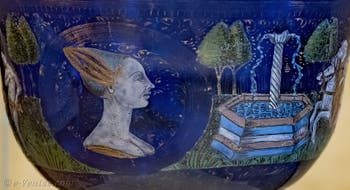The island of Murano and the Genius of Glass

Angelo Barovier Bridal Cup
It's all divine!
"I arrive from Murano, a small town built like Venice on the lagoons; it contains many factories of crystals and coloured glass beads.
It is amusing to witness the countless operations required by these little beads worn with such indifference, almost contempt, by our ladies.
This burning, red, pasty glass, rolled into long rods, then blown and shaped into elegant forms; this muffled roar of the devouring flame; these vast furnaces, these blackened men, this fragile result, have a picturesque side.
Angelo Barovier's bridal cup These nuanced atoms are collected by the bushel. In an instant, the worker fashions a vase or an urn that, if you looked at them, would seem to be the work of many days; baskets are filled with sparkling globes; the inside of the kiln, which spews out sprays of flames, casts a crimson hue on the smoky walls.
Then the walk across the lagoons to get there, and back again; the blue of the sea of the sea, the blue of the sky, the lazy pleasures of the gondola, everything is divine. is divine."
Valérie Gasparin - Journey of an ignorant woman 1835
Princess Babiole is on the prowl
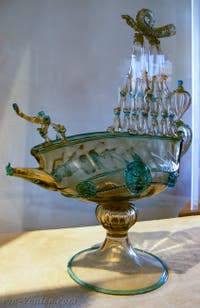
Boat-shaped decanter
"Princess Babiole prowls and circulates through everything, elusive, in the midst of a people of conjurers, under a prestigious sky.
She is the one who knows neither wood nor stone, neither pillars nor vaults, the spirit of reflections, gilding and marble, the soul of glass and thread.
The slightest of his gestures evokes a celebration in a futile object, and so small is everywhere her pretty toil that one trembles and smiles, so ephemeral does she appear, so charming is it that it serves no purpose at all"
Adrien Mithouard - The steps of the West Venice 1910
Glass: The life of the human breath
"Yes, you are a Seguso!" said Effrena, who was examining him. Your hands are proof of your nobility.
Reliquaries and religious vases The glassmaker, with a smile, looked at their backs and palms.
- Bequeath them in your will to the Murano Museum, along with your blowing rod.
- Si, perché i le meta in composta corne el cuor de Canova e le vissole padovane!
("Oui, pour qu'on mette en compote comme le coeur de Canova et les griottes de Padoue!")
The frank laughter of the workers ran around the altar and the nascent goblets swayed at the end of the canes, pink and bluish like the corymbs of the hydrangea that is beginning to change colour.
- But the decisive proof will be your glass. Let's have a look. [...]
Seventeenth century glasses and chalices The workers tilted their faces towards him, while exposing the cups attached to the end of the canes to the fire, to prevent them from cooling.
And the flames, clear as the crackling leaves of the laurel, waved across the parafires, seeming to hold the men captive by the tools of the art.
[...] The master glassmaker, holding the stem of the bowl between his thumb and forefinger, smiled at the actress, his face lit up by this warm praise.
Nuptial Cup by Angelo Barovier His air of subtlety and sagacity was reminiscent of the little golden fox that runs on the cock's tail in the Murano coat of arms.
His eyelids, reddened by the violent reflections, fluttered as he turned his gaze to the fragile work that still glistened in his hand before he left; and his caressing fingers and his whole attitude revealed the hereditary ability to feel the difficult beauty of simple lines and fine colourations.
Seventeenth century bottle She was like one of those miraculous flowers that bloom on scrawny, twisted shrubs, the cup held by the stooped man who was its creator.
Very beautiful indeed, this cup, and mysterious like natural things, preserving in its concavity the life of the human breath, rivalling in its transparency with the waters and the heavens, similar in its purple fringe to the jellyfish that float on the seas, simple, pure, with no other ornament than this marine fringe, with no other limbs than its foot, its stem and its lip.
And why she was so beautiful, no one could have said, not in a word, not in a thousand. thousand.
And its price was nil or incalculable, depending on the quality of the eye that contemplated it."
Gabriele d'Annunzio - The Fire
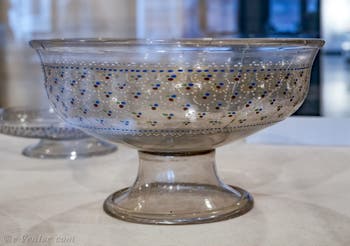
Footed bowl, multicoloured enamels and gold
"At the ancient Palazzo Sernagiotto, we witnessed the most extraordinary transformations that glass undergoes under the fingers of a skilled craftsman.
It can be found in the shape of artificial eyes, drawn as thin as strands of silk and then bent to the whims of the inventive man; it can be used to make trays, coasters and even, I believe, ties.
The enchanting millefiori are made on the island of Murano using sand from Polà, on the Istrian coast.
This industry was flourishing as early as 1489."
Georges Bastard - 50 days in Italy 1878
The glitter and apparent luxury of wealth
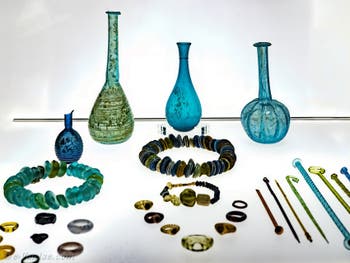
Decanter, necklaces and rings
"Murano is home to the ancient glassworks to which Venice once owed part of its industrial fame, and which still maintain a large trade, especially with the Levant.
These factories have preserved the secret of their means of manufacture, and make at very low prices a host of charming little objects, such as pearls, bracelets, necklaces, which serve as ornaments for the women of the people: poverty can thus afford the brilliance and apparent luxury of wealth."
Jules-Léonard Belin - The Simplon 1843
Rattle toys and churches for nuns and young girls
"A mile from Venice is a fairly large island, built with canals like the city.
Apollo and the muses, parade dish Several houses make up a small one called Murano.
It is a bishopric: the Republic holds a governor there as well as in all the towns or posts that may be important.
There are thirteen or fourteen churches in all.
The main one is paved with mosaic in the style of St. Mark's and supported by several antique columns where, to tell the truth, there is not much to see.
Apollo and the muses The little convent of girls, named des Anges, has a church which is not large.
The high altar with two small ones at the sides, are of good taste, the whole is of marble. The individual is not beautiful, but the whole together pleases me.
On the altar there is an "Annunciation" that I believe to be from Pordenone, which is fresh and wonderfully preserved. wonderfully preserved. I have seen several paintings of the old school in this place, which seemed good. that I thought were good.
The nuns' choir is infinitely clean and tasteful.
What makes Murano recommendable are its glassworks.
Religious vase Glazes are also made here, but they now have to give way to ours, either for size or for sharpness and the way they render objects.
Not so long ago, toys or rattles for nuns or young girls were made publicly in glassworks.
This did not prevent them from making one in front of me and providing me with a dozen for my friends.
Murano is still used as a guinguette in summer, and on Ascension Day the whole town on Ascension Day, the whole town comes to do the course.
It is held all summer from the Rialto bridge to from the Rialto bridge to the port."
Comte de Caylus - Journey to Italy 1714-1715
Un Vieux Refrain de Barcarolle
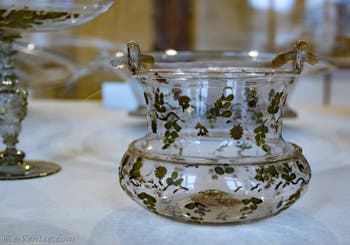
Murano glass bucket
"They model, for me, a small flask in the colours of Italy, which grows in the flame like a fairy flower; they turn the blazing paste with their brown faces move across the furnace, where, as they breathe, a thousand loose tubes are formed.
The fire of the forges and glassworks must be as intoxicating as mulled wine, for all the blacksmiths and glassmakers sing furiously as they beat the iron or twist the glass.
The Murano workers sing an old barcarolle refrain in front of me, which they turn into a prophetic threat against the Tedeschi (Note Visit-Venice-Italy.com: at this time Venice is occupied by the Austrians).
Wedding cup by Angelo Barovier The mirror factory is located in Murano on the other side of the canal, where the pearl factory is; now only French mirrors are made in Venice.
The factory is run by a Parisian, who puts modern industry far above the old, and would be careful not to produce, or rather reproduce, those artistic mirrors and splendid chandeliers of Venice, so sought after by connoisseurs.
I visit Murano's two old churches, that of San Pietro Martyr and that of degli Angeli.
In the former is a Madonna by Giovanni Bellini and Saint Jerome by Paul Veronese.
The second church dates back to the ninth century, and a bas-relief and an inscription attest to its age. Murano has been inhabited since the fifth century, when coastal fugitives took refuge here from the invading Huns.
Wedding cup by Angelo Barovier The island of Murano remained independent from Venice for a long time; in the eighth century, a Venetian podestate governed it.
All its inhabitants are glassmakers or sailors; great poverty reigns in Murano today, as in the whole of Veneto.
Houses and monuments there are falling into ruin.
I look at a beautiful facade, whose long gallery supports an elegant terrace.
It was once a convent of nuns, famous in the gallant annals of Venice; under these light arcades, the foolish virgins appeared on beautiful summer nights."
Louise Colet - The Italy of Italians 1862
The making of mirrors, account by Charles de Brosses
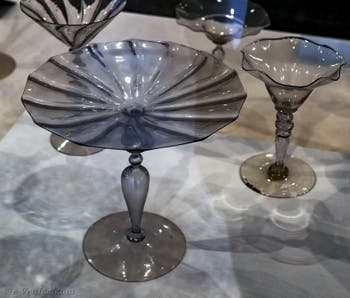
Stemmed glass 16th century
"I'm just back from Murano, where I went to see work at the glass factory.
They are not as large or as white as ours; but they are more transparent and less prone to having defects.
They are not cast on copper tables like ours; they are blown like bottles.
Extremely tall and sturdy workers are needed to do this work, especially to swing these large crystal globes in the air, which are held by the long iron rod used to blow them.
Dragées cup or reliquary The worker takes a large quantity of molten material from the crucible of the furnace at the end of his hollow rod: this material is then sticky and in the consistency of gum.
The workman blows it into a hollow globe; then, by swinging it in the air and presenting it at any moment to the mouth of the furnace, in order to maintain a certain degree of fusion, always turning it very quickly, to prevent the material presented to the fire from flowing more on one side than the other, he manages to make a long oval of it.
Then another worker, using the tip of a pair of scissors, made like sheep-shearing shears, i.e. they widen when the hand is released, pierces the oval at the end.
Emelled glass carafe 15th The first worker, holding the rod to which this globe is attached, turns it very quickly, while the second gradually releases the hand holding the scissors.
Then it is detached from the first iron rod, and sealed again, by the open end, to another rod made on purpose; then it is opened by the other end with the same mechanism as described above.
The result is a long cylinder of ice with a large diameter, which, by turning it, is represented at the mouth of the furnace to soften it a little more; and, on leaving there, in the twinkling of an eye, with a single stroke of the chisel, the ice is cut lengthwise, and promptly laid flat on a copper table.
All that remains afterwards is to anneal it further in another oven, then polish it and tin it as usual."
Le Président Charles de Brosses - Familiar letters 1739-1740
True artists
"The town, with a population of nearly 4,000, enjoyed franchises and special rights from the 13th to the 18th century due to the noble industry industry, which is still its speciality.
16th century pellerin flask The citizens of Murano could aspire to the highest offices in the Republic.
Master glassmakers were gentlemen by right, and children born of the union of a Venetian patrician and the daughter of a glassmaker inherited their father's dignity.
We pass through rooms where workers, quietly seated in front of spacious tables, seem to be busy with the wood-cut assembly game so popular with children.
But here the wood-cut is replaced by piles of small glass cubes of all colours.
Each worker has a piece of paper in front of him on which is reproduced a fragment of the model to be executed.
Enamelled and gilded dish He searches through his range of tones, as if for a tapestry, for the small cube that suits, sticks it in its place on the paper and, moving from one shade to another, ends up covering this paper which, together with those of the other workers, forms a more or less vast surface that is applied with special plasters to a façade, around a column or in a cupola to be decorated.
Once the panel is dry, all that remains is to peel off the primitive paper and the mosaic appears unaltered, with its gold backgrounds and all its nuances.
Enamelled and gilded dish The inevitable little glass dog, executed in one minute, is offered to us, provoking the tip and announcing the end of the visit.
The glassblowers and moulders are such hard labour that you have to rely on atavism to recruit workers.
Only glassblowers passed down from father to son can stand working in front of the furnaces, and even then they have to come from childhood and get used to this temperature every day until they are old enough to become workers themselves."
Eugène Faugière - Italy Notes and Sketches 1905
Filling the vases made with wine
"The pearl factories, so ancient in origin, on the island of Murano first attracted us.
Seventeenth century table spoons In the fiery furnace, we watched these famous manufacturers, whose ancestors Henry III ennobled, amazed as he was at the products of their work.
We followed all the transformations undergone by silica, the earth we walk on, before it became a pearl, a vase or a marvellous fabric.
Let's not despise anything. Let us despise nothing: the diamond is in the coal, which we use for the most vulgar purposes.
Thus, truth is wrapped up in universal and common thought: all that is needed is to know how to extract it and bring it to light.
Reticella glass dish The distinguished gentlemen of Murano had us blowing into their tubes to initiate us into the processes of their industry.
It was as good as over among us.
But then we were told that it was customary
to blow into the tubes.
Quod volet usus,
Arbitrium est et jus et norma
To fill the vases we had made with wine.
Our vases were wineskins: we had to comply with good grace."
Flandin - Travel 1838
Pearls of colour
"Murano has indeed fallen from its ancient splendour; it is no longer, as it once was, the magician of false pearls, glazes and glassware.
Glazed Murano glass vials Chemistry has revealed its secrets; it no longer has the privilege of these beautiful bevelled mirrors, these large glasses with filigree stems, these ribboned drinking vessels with milky spirals, these crystal balls that seem like a tear from the sea frozen on delicate oceanic vegetation; these rassades that rustled on the loincloths of black African women.
Bohemia is just as beautiful, Choisy-le-Roi is better.
Art, in Murano, has remained stationary in universal progress.
We visited one of its glassworks, where small coloured pearls were being made.
Long hollow threads of different shades, some transparent, others opaque, are chopped into small fragments, then rolled in boxes until rubbing has rounded them off; they are polished, then these beads are threaded with horsehair and joined together into hanks.
Seventeenth century stemmed glasses A bottle with a ribbon of white and pink filigree was blown for us.
Nothing is simpler and more expeditious than the process.
The glassblower was a tall, handsome man with black, curly hair, whose ruddy face was hardly in keeping with the prejudices people once had about this profession, which was reputed to be deadly, and which poor gentlemen were allowed to practise without exception.
He took a bit of molten glass from the end of his tube, amalgamated in it the thread of colour he wanted to turn at the same time, and with a single breath blew his piece, which swelled up frail and light as a soap bubble.
Vase decorated with diamond-point engraving (Note e-Venise.com: Venice was occupied by the Austrians at the time)
Murano contains another curiosity that we were made to see with a certain pride, a horse, an animal more chimerical in Venice than the unicorn, the griffin, the coquecigrues, the flying goats and the nightmares.
Richard III would cry out in vain: "My kingdom for a horse." It gave us a certain pleasure to see this honest quadruped, whose existence we had begun to forget.
Meeting this horse gave us a sort of nostalgia for terra firma, and we returned to Venice all dreamy."
Théophile Gautier - Italia 1855
An elegant and fragile industry
"Similarly, of the three hundred glass factories that the island had in the good old days, there are now only about fifteen left.
Falsca bivalve, early 17th century This elegant and fragile industry had been brought there by the first settlers of the Archipelago.
It was in Murano that the enamel used by the mosaicists of the primitive age was prepared; it was from its workshops that came the delicate, multicoloured pearls that played such an important part in the transactions of the city of the Doges, and then the goblets, vases, bowls, stained-glass windows and mirrors, works that were constantly being perfected by veritable dynasties of manufacturers, such as the Beroviero family, whose kiln was so renowned in the 15th century.
In those days, glassmakers were and deserved to be likened to artists.
The trade comprised six branches of workers: verieri, fioleri, fornasieri, crystal and pearl workers, mirror makers, and stazioneri or ushers.
Sixteenth-century stemmed glasses Night and day, the work never stopped as long as the factories were in operation, which meant forty-four weeks.
At the beginning of the 16th century, a Venetian invented the idea of making fake blown pearls: a new branch was born, that of the soffialume (blower).
It is not known exactly who invented the famous mirrors that decorated the flats of princes and kings at the time; all that is known is that in 1507 the Gallo brothers found the definitive way of replacing the polished metal plates that had hitherto been used as mirrors with glass surfaces covered on the reverse with tin foil.
Finally, in 1605, the Murano artists succeeded in colouring the crystals, without altering their transparency.
Wedding cup by Angelo Barovier Need we remind you of the jealous supervision the Venetian government exercised over this most precious of all industries?
The same Senate of the city of the lagoons that forbade, on pain of death, allowing Titian's Saint Peter Martyr to leave the territory of the republic, had prohibited, as early as 1275, not only the export of raw glass as well as the materials used to make it, but also that of broken glass, for fear that foreigners, by analysing it, might catch on to the process of the people of Murano.
In the seventeenth century, when Louis XIV, with the help of his secret emissaries, succeeded in hiring a certain number of Venetian workers, the Council of Ten went so far as to pay agents to kill any deserter who refused to return.
All these precautions did not prevent French production from gradually competing with Murano's, and the emigration movement from becoming more pronounced over the next hundred years."
Jules Gourdault - Venice and the Veneto 1886
Some crystal vases are called Arétins
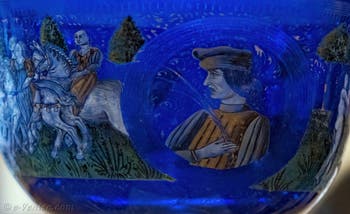
Wedding cup by Angelo Barovier
"Also, I swear to you by the wings of the horse Pegasus, of my fame you don't know the half of it.
I've said it many times and I'll say it again: medals struck in steel, cast in gold, silver, copper, lead and stucco display my portrait on palace facades, comb cases, mirror frames, earthenware dishes, on a par with Alexander, Caesar and Scipio.
In Murano, I can tell you, certain types of crystal vases are called Arétins.
Arétine is the name of a breed of Arabian horse in memory of one given by Pope Clement, which I then gave to Duke Frederick.
Canal de l'Arétin, so called the one that runs along one side of the house I live in on the Grand Canal.
And to make the pedants croak even more, apart from the fact that we talk about "Arétin style", three of my servant-governors who left me to get married call themselves the Arétines..."
Letter from Pietro Aretino known as the Aretin, to Messire Iunio Petreo - Venice May 1545
The island of Murano, a small-footed Venice
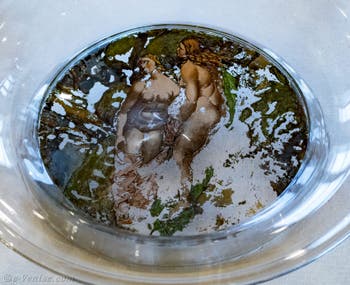
Plate depicting Raphael's dream
"Murano cuts its bell towers and roofs against the blue sky.
It's a famous island and well worth a visit. Murano is a small-footed Venice; like it, with its Grand Canal winding through its old hovels, the remains of princely palaces and opulent casinos.
It was here, in fact, that the noble Venetians of the other century had their little houses.
They came here in fine part, and these walls, now cracked and decrepit, very often resounded with the bursts of joyous laughter and the clink of glasses.
Behind their discreet shadows, they have sheltered more than one loving couple and protected many a friendly rendezvous.
Seventeenth-century vases and flasks Today, Murano is the home of industrial Venice.
This is where the glass and glassware that are so justly famous are made, those filigree glass filigrees that seem to have been woven by the fingers of a fairy.
It is one of the oldest art industries to have remained in Europe in the hands of one population without ever ceasing to be exploited
.
Murano has been home to glass artists since the 8th century.
Eighteenth century glass In 1201, the number of glassmakers increased dramatically, as a decree by the Senate obliged glassmakers living in Venice to move to the island of Murano.
The text of this decree is even interesting to remember, as it proves the high esteem in which this industrial art was held by the Venetian Senate.
In fact, it begins with these words: "Ut ars tam nobilis semper stet et permaneat in loco Muriani..."
The considerable fires that had broken out for some time in the fires that had broken out for some time in the main districts, made this move essential.
From this time onwards, production on the small island expanded enormously.
The glass was coloured, precious stones were imitated, and the delicate, slender shapes, elegant cones, charming goblets, light and graceful bottles and goblets that we still marvel at today were created.
Barovier wedding cup 15th Then came the Venetian mirrors, chandeliers and girandoles.
Everyone wanted them, the old continent and the new.
Goblets, platters and cones made their way to the courts of Europe, while glassware made its way to the Americas, India and as far away as Asia.
The Chinese themselves wore buttons from the Murano glassworks; at least Macartney claims so, and no one has dared to deny it.
Henry III, when he passed through Venice, wanted to visit these fine establishments.
He was so amazed by the magnificent products that came out of these factories, that he created a number of the artists-engineers who ran them as gentlemen.
Barovier wedding cup 15th Even today, the glass industry in Murano employs a large number of workers and enjoys undisputed fame in the industrial world.
The Cafres and Ilottentots continue to be its tributaries, as do the elegant people of Paris and the enthusiasts of London.
One institution that clearly illustrates the importance of this fine manufacture is the retrospective museum that has been set up in Murano itself, in which an effort has been made to bring together glassware from all periods and of all models.
This museum is still far from complete, but it contains a wealth of documents of indisputable interest. of indisputable interest."
Henry Havard - Amsterdam and Venice 1876
Montesquieu suffers shortage of filagram glass
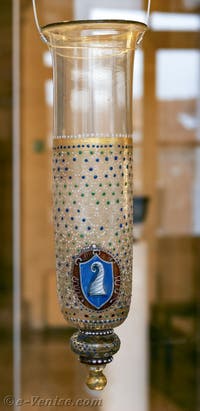
Lamp "Cesendello"
"There is a great trade in Europe in certain glass beads which are made in Murano and fashioned in Venice, which are sent to Italy and in the rest of Europe, for the Indians and Negroes.
Because, for the filagrammed glasses, worked and coloured, that I saw in Murano, it is shopkeepers and the fair of Sinigaglia who buy a lot of these glasses; which meant that the shops I saw of them were almost empty."
Charles-Louis de Secondat Baron de Montesquieu - Travels 1728-1729
Colbert is interested in the manufacture of glass
"I went today to Murano, which is a small town about a mile away from Venice, where all the glazes and glassworks that are made in this country are made.
I saw glassworkers there; they are more skilful than those we saw in France. I did not, however, see any larger mirrors being made; but what I was able to observe there made me easily understand what kind of work is required for this type of work."
Jean-Baptiste Antoine Colbert Marquis de Seignelay - Italy in 1671
Back to Top of Page


